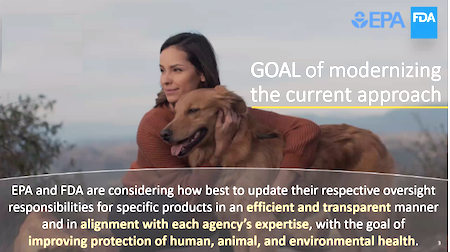Amid rising concerns over potential adverse events and possibly deadly flea-and-tick collars, the Environmental Protection Agency’s plan to transfer regulation of such products to another agency (FDA) drew skepticism from animal and environmental advocates at a virtual public meeting this week.
Background Information
The EPA /FDA proposal and meeting came about two years after media and investigative organizations published a report that revealed that the EPA did not initiate any action on tens of thousands of adverse incident reports linked to the best-selling flea-and-tick collar: Seresto. The EPA, whose officials said they lack the staffing and resources to adequately assess and monitor the products’ safety, wants to relinquish oversight of all such pet pesticides to the Food and Drug Administration. The FDA is a co-sponsor of the plan.
The media organizations’ reporting sparked congressional action and public outcry over the agency’s lack of regulation of the collars, which, according to data gathered, “have since racked up more than 100,000 reports of harm to pets and people, including 2,698 pet deaths.”
The EPA believes that this is a helpful solution and they state that “Our agencies understand and share the concerns that many of you have around these products because pets hold a really special place in our hearts.” However, advocates said they worry the EPA is trying to shirk its duties to protect people and fear the FDA lacks the ability to assess the products’ environmental hazards. “The proposed transfer in regulation can’t be a substitute for taking action on harmful products,” said Lori Ann Burd, environmental health program director for the Center for Biological Diversity, one of dozens of people who spoke at the two-hour hearing.
Burd said she regularly hears from pet owners whose pets have been harmed or died after wearing these best-selling flea-and-tick collars. Many of those people have attempted to contact EPA and have not heard back, she said, adding “the EPA has an obligation to do something to limit current and potential harm, not just transfer authority to FDA.”
Bill Jordan, a representative of the Environmental Protection Network, which is made up of former EPA staff, expressed concerns that the FDA might not have the regulatory authority to properly assess risks to the environment from pet products.
“Chemicals used in topical flea and tick treatments, such as imidacloprid and fipronil, can cause problems for wastewater facilities because the pesticides poison the water, leading to Clean Water Act violations and causing problems with reusing the water,” said Cynthia Finley, director of regulatory affairs for the National Association of Clean Water Agencies.
EPA/FDA Plan would bring regulation ‘into the 21st century’
Top officials from both agencies were present at the meeting but did not specifically address remarks by the speakers. Instead, they gave a short presentation about the proposal that emphasized the need to overhaul the current regulatory system. Ellen Hart, veterinary medical officer at the FDA, said the government’s understanding of science has evolved and the proposal is designed to bring regulation of pet pesticide products “out of the 1970s and into the 21st century.”
